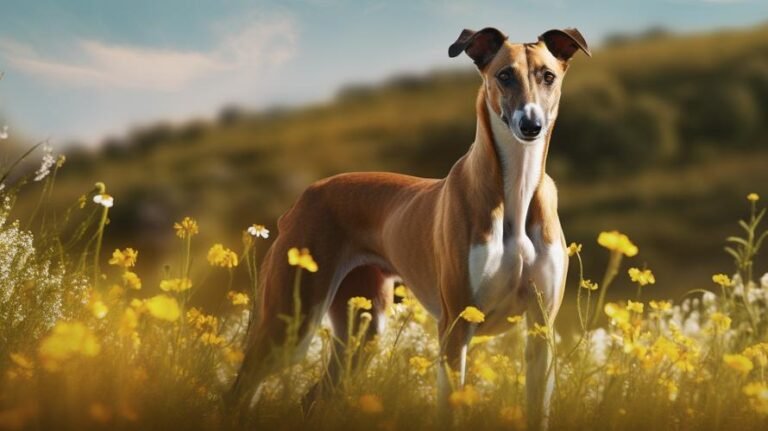Imagine a rocket disguised as a dog, a graceful creature that can bolt from zero to 45 miles per hour faster than the latest electric sports car. Yes, that blur whizzing past you in the dog park is likely a Greyhound, one of the fastest breeds on the planet. With their sleek bodies and whippet-quick pace, it’s clear they’re a special kind of dog. But does their uniqueness extend to their diet? Let’s dive into the world of Greyhound nutrition and find out.
Greyhounds aren’t your average couch potatoes (well, when they aren’t sprinting, that is). Their athletic prowess means they have different dietary needs compared to, say, a leisure-loving bulldog or a yappy Yorkie. So, what’s the dish on feeding these speedsters?
First up, Greyhounds have more muscle mass compared to other breeds, which means they need a good amount of protein in their diet to maintain those rippling muscles. Good quality meat as the first ingredient? That’s not just a luxury for these canines, it’s a necessity! But not just any protein; we’re talking about high-quality sources like chicken, turkey, beef, or lamb.
But wait, before you start thinking a meat-only buffet is the answer, these dogs also need their veggies. Yes, even these fast and furious canines can’t escape the health benefits of the green stuff. This is where vitamins and minerals come into play. Carrots, sweet potatoes, and green beans make excellent additions to a Greyhound’s dinner plate (or bowl). They help support everything from their super vision to their “built-for-speed” bodies.
Now, you might be thinking, doesn’t all dog food have protein and vegetables? True, but not all dog food is created equal. Greyhounds need concentrated energy sources due to their rapid metabolism. That means healthy fats are their best friends. The fats help maintain their energy stores and keep their coat as glossy as a freshly waxed sports car.
“Carbohydrates,” you ask? Greyhounds need them too, but as with any high-performance machine, the quality of the fuel matters. Complex carbs provide them with sustained energy, perfect for recovery after a spirited sprint or a long day of being your beloved, elegant pet. Think brown rice, barley, or oats – not the processed, sugary stuff that can cause energy spikes and crashes.
Hold your horses, though—not literally, horses are for another day. Greyhounds can be more sensitive than a high-strung diva when it comes to their stomachs. Run-of-the-mill dog food that’s brimming with artificial colors, flavors, or fillers can upset their digestive system. Greyhound owners quickly learn that a happy tummy makes for a happy, tail-wagging friend.
Because these dogs are serious about their lounging time when they’re not racing around, it’s key to manage their weight carefully. Overfeeding a Greyhound can lead to obesity, which is the nemesis of their lean, mean running machine status. Portion control matched to their activity level is crucial.
Now, let’s address the age-old debate: wet food or dry food for the regal Greyhound? Some argue that wet food keeps them more hydrated, which can be beneficial since Greyhounds don’t always gulp down as much water as they should. This can be especially true in hotter climates where these dogs risk eviction from their “cool club” status due to dehydration.
On the other hand, some pet nutritionists argue that dry food can be better for dental health, which even Greyhounds, with their aerodynamic heads and impressive teeth, need to manage. It’s like deciding between a sports bike or a cruiser; both have their pros and cons, and sometimes a mix of both is the perfect balance.
Lest we forget, Greyhounds are also individual canines with their own likes, dislikes, and even food allergies. What works for one speedy pupper might not work for another. Knowing your dog and watching how it reacts to different foods is key. You can’t just base the diet on breed alone.
But what about supplements? With these athletes, joint health is top of mind, and supplements like glucosamine and chondroitin can be beneficial. Omega fatty acids—those are like premium oil for your car’s engine—keep the Greyhound’s joints well-lubricated and their coat lustrous. However, offering a well-rounded diet could also reduce the need for additional supplements.
Speaking of a well-rounded diet, treats are important too! But just as you wouldn’t throw sugar into your car’s gas tank (terrible idea, by the way), you should avoid overindulging Greyhounds with unhealthy snacks. They can get the same excitement from healthier options like blueberries, apple slices (minus the seeds, of course), or a piece of carrot.
Training treats? Yes, they truly are the high-octane rewards for Greyhounds. Yet these should be small, low-calorie, and used sparingly. You wouldn’t give an athlete a feast before a race, right?
Let’s also chat about schedule. Greyhounds thrive on routine like a finely-tuned metronome. Setting a feeding schedule helps prevent bloat, a dangerous condition where a dog’s stomach can twist after eating too quickly or too much. Smaller, more frequent meals are far better than a giant feast once a day.
So, feeding a Greyhound is no small feat; it’s more like meal planning for an Olympian. But for all their dietary needs, they give back tenfold in companionship and sheer awe as you watch them sprint through life with joy—after all, who else could make your heart race just by running towards you with that signature Greyhound grin?
Their diet might require some particular care, but these dogs remind us that ‘special’ doesn’t mean ‘complicated.’ It means ‘crafted with love.’ Whether you’re opting for premium kibble or cooking homemade meals fit for a canine king or queen, each dish you prepare for your Greyhound is a testament to the unique bond between humans and their fast, furry companions.
At the end of the day, what matters most is that these athletes-turned-companions have their dietary needs met so they can continue to live, love, and possibly outpace us all at the track—or in the hallway towards the food bowl!



